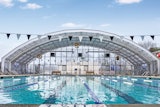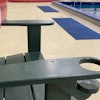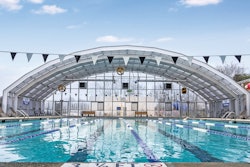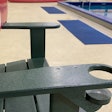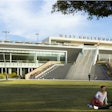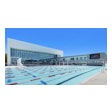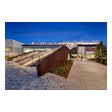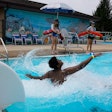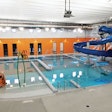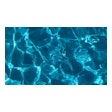Anyone who has spent time around indoor pool facilities can likely relate to the challenge of maintaining desired air quality within those spaces. All too often, the humidity is too high, the air smells bad and the temperatures are either too high or too low. In some extreme cases, the air quality is so degraded it can present health hazards and/or create conditions that keep people away.
By contrast, facilities with properly sized and designed systems will boast environments that are not only comfortable and inviting, but save money in the forms of energy-efficient operations and reduced maintenance. Although maintaining good air quality is an issue that challenges facilities across a wide range of settings — from weight rooms and yoga studios to gyms and arenas — indoor pools and spas face problems those others do not. Simply put, open bodies of water evaporate, thus raising humidity to potentially uncomfortable levels while also generating condensation, which in turn leads to the growth of mold and other problems.
ENCLOSED ENCOUNTER
For businesses that rely on the popularity of their indoor pools and spas as a primary attraction, the common problems associated with poor air quality can be financially crippling — a problem that becomes even worse when the systems used for managing air quality break down, requiring expensive repairs or even replacement and costly downtime.
Regardless of the severity of such problems, the fundamental challenge remains the same. "The main issue is, of course, what to do with the water vapor that forms over a pool in an enclosed space," says Marcy Glatfelter, inside sales manager at PoolPak International LLC, a manufacturer of dehumidification systems.
"As moisture fills the structure," she continues, "damage can occur and, in general, the environment becomes uncomfortable for occupants. Before the advent of modern dehumidification systems, doors and windows were left open, providing minor relief from the humidity. Fans were later added to help draw out moisture and maintain a balance, but this method also proved only marginally effective, especially in colder climates where heating was required."
According to Glatfelter, natatoriums in best-case scenarios are designed and engineered with air quality in mind long before they're built. Unfortunately, in far too many situations, owners and managers find themselves already saddled with insufficient systems and left facing expensive retrofit solutions, or opting for partial measures that don't effectively address the problem. In almost all instances, the air-quality challenge can be surprisingly nuanced.
SITE SPECIFICS
First and foremost, it's crucial to realize that there is no such thing as a one-size-fits-all solution to air-quality issues associated with indoor pools. Virtually every facility is different, with key variables including:
- Building's architecture
- Cubic air volume of the enclosed space
- Surface area of the water
- Daily hours of use
- Types of use
- Bather loads
- Climate
- Operating and construction budgets
- Quality and frequency of maintenance
Despite the broad variability, there are a couple of key benchmarks that apply across the board. According to standards maintained by the American Society of Heating, Refrigerating and Air-Conditioning Engineers (ASHRAE) and many state and local health departments, humidity inside a natatorium should be maintained at a comfortable 50 to 60 percent. Beyond that, occupants start to feel uncomfortable.
In most situations, air temperature should also be 80 to 82 degrees. That standard stems from the recommended water temperatures for exercise and competition pools of 78 degrees. The idea of keeping the air 2 to 4 degrees warmer than the water is optimum for bather comfort. Achieving and maintaining those basic parameters involves factoring in the above-mentioned variables. And that's where things get tricky.
"Indoor pool designers and contractors need to control and balance five crucial variables that include indoor air quality, occupant comfort, energy cost, pool water chemistry and asset protection," says Glatfelter. "The interrelationship between the variables is complex, and changing one or more may affect the others. Small variations in the pool environment may result in discomfort. Large imbalances in the pool environment can result in very high operating costs, destruction of equipment and structure, and even occupant injury."
How designers and builders address those key factors comes down to looking at the entire natatorium design. "Understanding how the architectural design impacts the systems that control air quality is critical," says Kevin Ruddy, owner of Omega Pool Structures, a designer/builder with a lengthy history of working with commercial indoor pool facilities. "The first consideration is you want a big cubic volume of air over that pool so that whatever type of air-handling or dehumidification system you put in, there's greater chance of controlling the environment."
As Ruddy points out, in many situations, especially those in which the pool has been retrofitted into an existing facility, the room's volume is badly limited, often by low ceilings. "At a minimum you want to have at least 15-foot ceilings above the pool's surface. The higher the better," Ruddy says. "When you're dealing with a small cubic volume of air space, whatever system you use is going to have to run longer to manage the humidity. Relatively speaking, that's going to make any system less efficient and more prone to failure."
Beyond sheer volume, the ceiling design itself is important to consider. According to Jeffrey Boucher, vice president and managing partner with Drakeley Pool Company LLC, a designer/builder with extensive experience creating natatoriums, "The contours of the ceiling, with peaks and ridges, can create dead spots where heat and moistures will accumulate if there's no air movement in those areas. You have to be sure that airflow is delivered to and vented from those areas."
The presence of windows, both in the walls and ceiling (in the form of skylights) is another important element requiring special attention. Even in mild climates, there will be extended periods during which outside temperatures are significantly lower than those maintained inside — differentials that will inevitably result in condensation on the interior glass surface. "Wherever there's glass, you have to wash that surface with warm air," says Boucher. "Regardless of the type of system you're using, proper air distribution over glass is a priority."
Proper vapor barriers and insulation, or lack thereof, can also have a big impact on air-quality control, as well as the prevention of mold. "You do not want any level of moisture transfer between the inside and outside," says Boucher. "That usually means a layer of some type of plastic material between the interior finish material and the insulation, which will absorb water. Once that happens, you'll never get it out short of removing the insulation and replacing it."
 Click to enlarge
Click to enlarge
SYSTEM TYPES
In general, there are two categories of systems. Refrigerant-based systems, often referred to as direction expansion (DX) systems, remove moisture from the air similar to the way air conditioners remove water from condensation. Air make-up/ventilation systems pull fresh air from the outside, heat the incoming air and then vent inside air back out.
According to Glatfelter, of the two, DX systems are the most common dehumidification systems used for small to medium applications "due to their tight control of the space temperature, as well as overall good life cycle cost," she says, adding that "heat and moisture are removed the same way an air-conditioning system does it, with the major difference being the way the system reuses the recovered heat."
Glatfelter explains that in all DX systems, refrigerant vapor flows through the compressor, raising its temperature and pressure. The refrigerant then flows through the condenser, where it condenses to a liquid, giving off heat in the process. The refrigerant then goes through the expansion valve, where it experiences a pressure drop before going to the evaporator, where it absorbs heat, causing the refrigerant to vaporize again. In this state, it returns to the start of the cycle. This last phase, in which heat energy is drawn from the surrounding air, is the desired effect.
An important characteristic of refrigerant-based dehumidification systems used for pools is they are designed to use the waste energy to heat the water and/or air. Using a process known as "hot gas reheat," the heat removed from the moist air is added back to the air as it passes through the system. "The recycled energy, in many cases, can satisfy up to 90 percent of the pool's heating requirements," adds Glatfelter.
The benefit of these systems is measured in coefficient of performance (COP). Efficient dehumidifiers have a COP around 5, which simply means five units of heat energy are produced for every unit of electricity used. By comparison, air make-up/ventilation systems are far less sophisticated, more subject to outside humidity and temperature, and do not offer the ability to re-use heat from captured air moisture. However, they are also far less expensive.
"Many facilities rely strictly on air make-up systems, which were introduced as part of the Industrial Revolution for moving stale air out of the manufacturing facilities," says Ruddy. "There, of course, you're removing air from the space and introducing outside air, which, depending on the climate, will have to be heated in order to maintain a comfortable temperature."
"It's a brute-force approach to dehumidification under the premise that enough drier, outside air will offset the effects of pool evaporation," says Glatfelter. "This system has no self-contained means of cooling during the hot summer season, especially when the temperature difference between outside and inside is minimal. Although a chilled water coil can be incorporated from an external system."
Despite the significant advantages of refrigerant-based systems, the choice of technology is often a matter of budget. "It really comes down to dollars and cents," says Boucher. "With refrigerant systems, you often want to recapture the heat for the sake of energy efficiency. You can pay more upfront, but that's going to reduce costs over the long haul. Of course, the ROI depends on a variety of factors and, again, every situation is different."
Maintaining favorable air-quality conditions within indoor pool facilities is a multi-faceted challenge, one that requires balancing many factors. The good news is that the technology and expertise required to meet that challenge are readily available, and many measures can yield considerable savings over time.

BREATHE EASY: SIMPLE AIR QUALITY TIPS
For all the nuances of overall facility design and dehumidification technology, at least part of the challenge can be met with some fairly simple measures. Chief among those is the use of solid pool covers.
"Even in high-use facilities, such as a health club or YMCA, the pool is not going to be used overnight," says Kevin Ruddy, owner of designer/builder Omega Pool Structures. "That means half the time it's sitting there unused but still evaporating and adding moisture to the surrounding air. It only makes sense to cover it during those hours. Obviously, you're wasting energy and putting unnecessary wear and tear on the system. That's really just commonsense, yet we see facilities all the time where they don't use covers, and they wonder why the air's humid and their systems break down frequently."
Another helpful solution, albeit far more expensive, is the use of windows or skylights that open when the weather is warm. "We're seeing more facilities that are taking advantage of mild weather in the summer, where they simply open the windows or glass panels in the roof and let the drier air outside in," says Ruddy. "Depending on the climate, the investment in those structures can yield tremendous savings, because you don't have to run the system during those hours."
Even windows that don't open should be made to help maximize system efficiency. "Durable and triple glass panels are best, and they should be insulated or sealed in metal or vinyl clad frames wherever possible," says Marcy Glatfelter, inside sales manager at dehumidification systems manufacturer PoolPak International, LLC. "Window frames must have thermal breaks, and be sealed to adjacent walls and insulated with a non-porous insulating material."
In the past few years, stainless steel gutter manufacturers have introduced gutters that have vents built in, which have the advantage of venting air directly off the water's surface before it mixes with the surrounding air. As with covers or open-air structures, removing air from the water's surface using vented gutters does not eliminate the need for a dehumidification system, but they, too, can significantly reduce the workload required to maintain comfortable conditions.
- E.H.
This article originally appeared in the April 2014 issue of Athletic Business under the headline, "Clear the Air."









